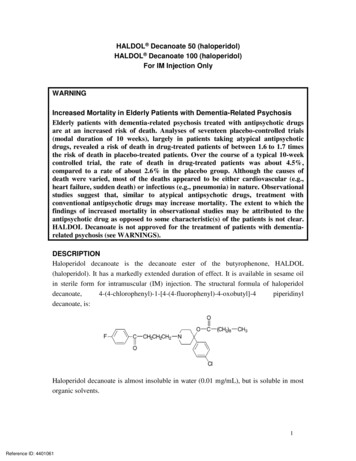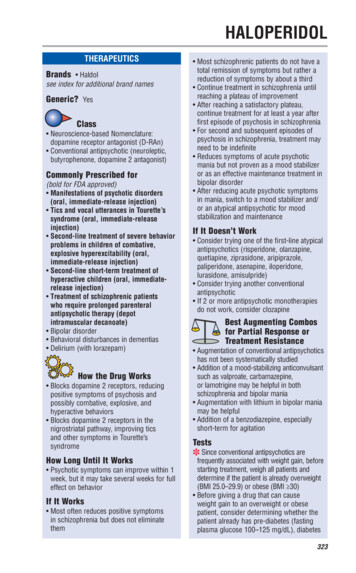
Transcription
HALDOL Decanoate 50 (haloperidol)HALDOL Decanoate 100 (haloperidol)For IM Injection OnlyWARNINGIncreased Mortality in Elderly Patients with Dementia-Related PsychosisElderly patients with dementia-related psychosis treated with antipsychotic drugsare at an increased risk of death. Analyses of seventeen placebo-controlled trials(modal duration of 10 weeks), largely in patients taking atypical antipsychoticdrugs, revealed a risk of death in drug-treated patients of between 1.6 to 1.7 timesthe risk of death in placebo-treated patients. Over the course of a typical 10-weekcontrolled trial, the rate of death in drug-treated patients was about 4.5%,compared to a rate of about 2.6% in the placebo group. Although the causes ofdeath were varied, most of the deaths appeared to be either cardiovascular (e.g.,heart failure, sudden death) or infectious (e.g., pneumonia) in nature. Observationalstudies suggest that, similar to atypical antipsychotic drugs, treatment withconventional antipsychotic drugs may increase mortality. The extent to which thefindings of increased mortality in observational studies may be attributed to theantipsychotic drug as opposed to some characteristic(s) of the patients is not clear.HALDOL Decanoate is not approved for the treatment of patients with dementiarelated psychosis (see WARNINGS).DESCRIPTIONHaloperidol decanoate is the decanoate ester of the butyrophenone, HALDOL(haloperidol). It has a markedly extended duration of effect. It is available in sesame oilin sterile form for intramuscular (IM) injection. The structural formula of uorophenyl)-4-oxobutyl]-4piperidinyldecanoate, is:Haloperidol decanoate is almost insoluble in water (0.01 mg/mL), but is soluble in mostorganic solvents.1Reference ID: 4401061
Each mL of HALDOL Decanoate 50 for IM injection contains 50 mg haloperidol(present as haloperidol decanoate 70.52 mg) in a sesame oil vehicle, with 1.2% (w/v)benzyl alcohol as a preservative.Each mL of HALDOL Decanoate 100 for IM injection contains 100 mg haloperidol(present as haloperidol decanoate 141.04 mg) in a sesame oil vehicle, with 1.2% (w/v)benzyl alcohol as a preservative.CLINICAL PHARMACOLOGYHALDOL Decanoate 50 and HALDOL Decanoate 100 are the long-acting forms ofHALDOL (haloperidol). The basic effects of haloperidol decanoate are no different fromthose of HALDOL with the exception of duration of action. Haloperidol blocks theeffects of dopamine and increases its turnover rate; however, the precise mechanism ofaction is unknown.Administration of haloperidol decanoate in sesame oil results in slow and sustainedrelease of haloperidol. The plasma concentrations of haloperidol gradually rise, reachinga peak at about 6 days after the injection, and falling thereafter, with an apparent half-lifeof about 3 weeks. Steady state plasma concentrations are achieved after the third or fourthdose. The relationship between dose of haloperidol decanoate and plasma haloperidolconcentration is roughly linear for doses below 450 mg. It should be noted, however, thatthe pharmacokinetics of haloperidol decanoate following intramuscular injections can bequite variable between subjects.INDICATIONS AND USAGEHALDOL Decanoate 50 and HALDOL Decanoate 100 are indicated for the treatment ofschizophrenic patients who require prolonged parenteral antipsychotic therapy.CONTRAINDICATIONSSince the pharmacologic and clinical actions of HALDOL Decanoate 50 and HALDOLDecanoate 100 are attributed to HALDOL (haloperidol) as the active medication,Contraindications, Warnings, and additional information are those of HALDOL,modified only to reflect the prolonged action.HALDOL is contraindicated in patients with: Severe toxic central nervous system depression or comatose states from anycause.2Reference ID: 4401061
Hypersensitivity to this drug – hypersensitivity reactions have includedanaphylactic reaction and angioedema (see WARNINGS, HypersensitivityReactions and ADVERSE REACTIONS). Parkinson’s disease (see WARNINGS, Neurological Adverse Reactions inPatients with Parkinson’s Disease or Dementia with Lewy Bodies). Dementia with Lewy bodies (see WARNINGS, Neurological Adverse Reactionsin Patients with Parkinson’s Disease or Dementia with Lewy Bodies).WARNINGSIncreased Mortality in Elderly Patients with Dementia-Related PsychosisElderly patients with dementia-related psychosis treated with antipsychotic drugsare at an increased risk of death. HALDOL Decanoate is not approved for thetreatment of patients with dementia-related psychosis (see BOXED WARNING).Cardiovascular EffectsCases of sudden death, QT-prolongation, and Torsades de Pointes have been reported inpatients receiving haloperidol. Higher than recommended doses of any formulation andintravenous administration of haloperidol appear to be associated with a higher risk ofQT-prolongation and Torsades de Pointes. Although cases have been reported even in theabsence of predisposing factors, particular caution is advised in treating patients withother QT-prolonging conditions (including electrolyte imbalance [particularlyhypokalemia and hypomagnesemia], drugs known to prolong QT, underlying cardiacabnormalities, hypothyroidism, and familial long QT-syndrome). HALDOLDECANOATE MUST NOT BE ADMINISTERED INTRAVENOUSLY.Tardive DyskinesiaA syndrome consisting of potentially irreversible, involuntary, dyskinetic movementsmay develop in patients treated with antipsychotic drugs (see ADVERSE REACTIONS).Although the prevalence of the syndrome appears to be highest among the elderly,especially elderly women, it is impossible to rely upon prevalence estimates to predict, atthe inception of antipsychotic treatment, which patients are likely to develop thesyndrome. Whether antipsychotic drug products differ in their potential to cause tardivedyskinesia is unknown.Both the risk of developing tardive dyskinesia and the likelihood that it will becomeirreversible are believed to increase as the duration of treatment and the total cumulativedose of antipsychotic drugs administered to the patient increase. However, the syndrome3Reference ID: 4401061
can develop, although much less commonly, after relatively brief treatment periods at lowdoses.There is no known treatment for established cases of tardive dyskinesia, although thesyndrome may remit, partially or completely, if antipsychotic treatment is withdrawn.Antipsychotic treatment, itself, however, may suppress (or partially suppress) the signsand symptoms of the syndrome and thereby may possibly mask the underlying process.The effect that symptomatic suppression has upon the long-term course of the syndromeis unknown.Given these considerations, antipsychotic drugs should be prescribed in a manner that ismost likely to minimize the occurrence of tardive dyskinesia. Chronic antipsychotictreatment should generally be reserved for patients who suffer from a chronic illness that1) is known to respond to antipsychotic drugs, and 2) for whom alternative, equallyeffective, but potentially less harmful treatments are not available or appropriate. Inpatients who do require chronic treatment, the smallest dose and the shortest duration oftreatment producing a satisfactory clinical response should be sought. The need forcontinued treatment should be reassessed periodically.If signs and symptoms of tardive dyskinesia appear in a patient on antipsychotics, drugdiscontinuation should be considered. However, some patients may require treatmentdespite the presence of the syndrome.Neuroleptic Malignant Syndrome (NMS)A potentially fatal symptom complex sometimes referred to as Neuroleptic MalignantSyndrome (NMS) has been reported in association with antipsychotic drugs (seeADVERSE REACTIONS). Clinical manifestations of NMS are hyperpyrexia, musclerigidity, altered mental status (including catatonic signs) and evidence of autonomicinstability (irregular pulse or blood pressure, tachycardia, diaphoresis, and cardiacdysrhythmias). Additional signs may include elevated creatine phosphokinase,myoglobinuria (rhabdomyolysis) and acute renal failure.The diagnostic evaluation of patients with this syndrome is complicated. In arriving at adiagnosis, it is important to identify cases where the clinical presentation includes bothserious medical illness (e.g., pneumonia, systemic infection, etc.) and untreated orinadequately treated extrapyramidal signs and symptoms. Other important considerationsin the differential diagnosis include central anticholinergic toxicity, heat stroke, drugfever and primary central nervous system (CNS) pathology.4Reference ID: 4401061
The management of NMS should include 1) immediate discontinuation of antipsychoticdrugs and other drugs not essential to concurrent therapy, 2) intensive symptomatictreatment and medical monitoring, and 3) treatment of any concomitant serious medicalproblems for which specific treatments are available. There is no general agreement aboutspecific pharmacological treatment regimens for uncomplicated NMS.If a patient requires antipsychotic drug treatment after recovery from NMS, the potentialreintroduction of drug therapy should be carefully considered. The patient should becarefully monitored, since recurrences of NMS have been reported.Hyperpyrexia and heat stroke, not associated with the above symptom complex, have alsobeen reported with HALDOL.Neurological Adverse Reactions in Patients with Parkinson’s Disease orDementia with Lewy BodiesPatients with Parkinson’s Disease or Dementia with Lewy Bodies are reported to have anincreased sensitivity to antipsychotic medication. Manifestations of this increasedsensitivity with haloperidol treatment include severe extrapyramidal symptoms,confusion, sedation, and falls. In addition, haloperidol may impair the antiparkinsoneffects of levodopa and other dopamine agonists. HALDOL Decanoate is contraindicatedin patients with Parkinson’s Disease or Dementia with Lewy Bodies (seeCONTRAINDICATIONS).Hypersensitivity ReactionsThere have been postmarketing reports of hypersensitivity reactions with haloperidol.These include anaphylactic reaction, angioedema, dermatitis exfoliative, hypersensitivityvasculitis, rash, urticaria, face edema, laryngeal edema, bronchospasm, and laryngospasm(see ADVERSE REACTIONS). HALDOL Decanoate is contraindicated in patients withhypersensitivity to this drug (see CONTRAINDICATIONS).FallsMotor instability, somnolence, and orthostatic hypotension have been reported with theuse of antipsychotics, including HALDOL Decanoate, which may lead to falls and,consequently, fractures or other fall-related injuries. For patients, particularly the elderly,with diseases, conditions, or medications that could exacerbate these effects, assess therisk of falls when initiating antipsychotic treatment and recurrently during treatment.Combined Use of HALDOL and LithiumAn encephalopathic syndrome (characterized by weakness, lethargy, fever, tremulousnessand confusion, extrapyramidal symptoms, leukocytosis, elevated serum enzymes, BUN,5Reference ID: 4401061
and fasting blood sugar) followed by irreversible brain damage has occurred in a fewpatients treated with lithium plus HALDOL. A causal relationship between these eventsand the concomitant administration of lithium and HALDOL has not been established;however, patients receiving such combined therapy should be monitored closely for earlyevidence of neurological toxicity and treatment discontinued promptly if such signsappear.GeneralA number of cases of bronchopneumonia, some fatal, have followed the use ofantipsychotic drugs, including HALDOL (haloperidol). It has been postulated thatlethargy and decreased sensation of thirst due to central inhibition may lead todehydration, hemoconcentration and reduced pulmonary ventilation. Therefore, if theabove signs and symptoms appear, especially in the elderly, the physician should instituteremedial therapy promptly.Although not reported with HALDOL, decreased serum cholesterol and/or cutaneous andocular changes have been reported in patients receiving chemically-related drugs.PRECAUTIONSLeukopenia, Neutropenia, and AgranulocytosisClass Effect: In clinical trial and/or postmarketing experience, events ofleukopenia/neutropenia have been reported temporally related to antipsychotic agents,including HALDOL Decanoate. Agranulocytosis has also been reported.Possible risk factors for leukopenia/neutropenia include pre-existing low white blood cellcount (WBC) and history of drug-induced leukopenia/neutropenia. Patients with a historyof a clinically significant low WBC or a drug-induced leukopenia/neutropenia shouldhave their complete blood count (CBC) monitored frequently during the first few monthsof therapy and discontinuation of HALDOL Decanoate should be considered at the firstsign of a clinically significant decline in WBC in the absence of other causative factors.Patients with clinically significant neutropenia should be carefully monitored for fever orother symptoms or signs of infection and treated promptly if such symptoms or signsoccur. Patients with severe neutropenia (absolute neutrophil count 1000/mm3) shoulddiscontinue HALDOL Decanoate and have their WBC followed until recovery.OtherHALDOL Decanoate 50 and HALDOL Decanoate 100 should be administered cautiouslyto patients:6Reference ID: 4401061
with severe cardiovascular disorders, because of the possibility of transienthypotension and/or precipitation of anginal pain. Should hypotension occur and avasopressor be required, epinephrine should not be used since HALDOL (haloperidol)may block its vasopressor activity, and paradoxical further lowering of the bloodpressure may occur. Instead, metaraminol, phenylephrine or norepinephrine should beused. receiving anticonvulsant medications, with a history of seizures, or with EEGabnormalities, because HALDOL may lower the convulsive threshold. If indicated,adequate anticonvulsant therapy should be concomitantly mainta
HALDOL Decanoate 50 and HALDOL Decanoate 100 are the long-acting forms of HALDOL (haloperidol). The basic effects of haloperidol decanoate are no different from those of HALDOL with the exception of duration of action. Haloperidol blocks the effects of dopamine and increases its turnover rate; however, the precise mechanism of action is unknown.











